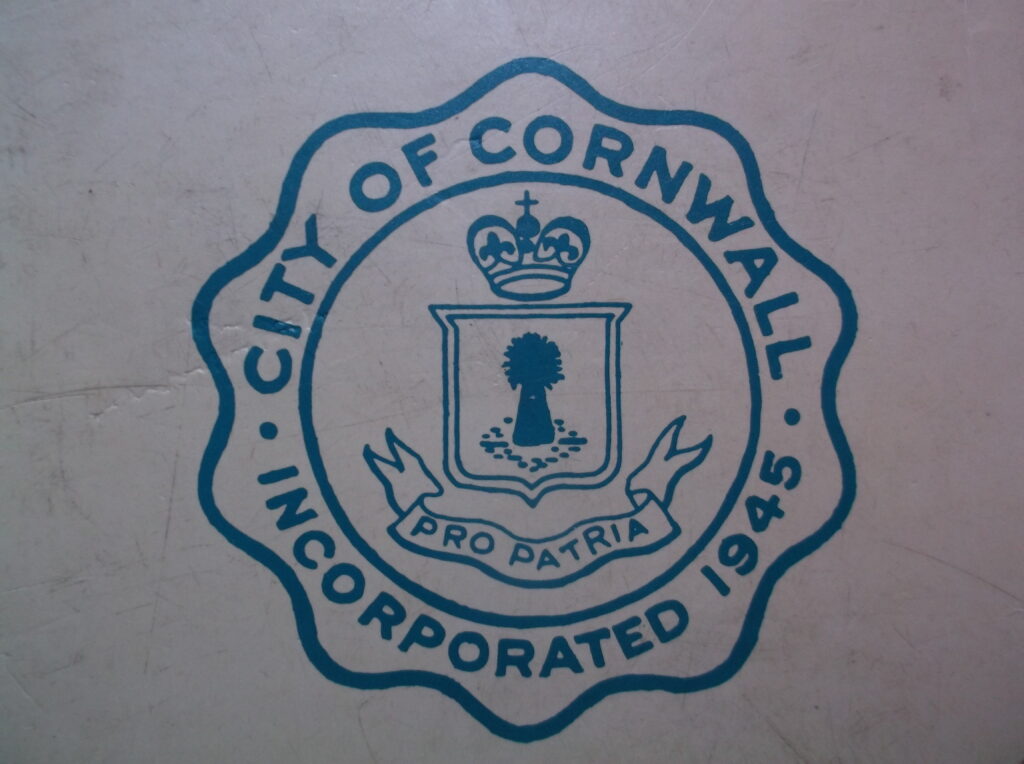CORNWALL’S HERALDIC SYMBOLS.
Symbols, such as a coat of arms, representing sports teams, countries, provinces, and cities are important. At their best they can evoke, familiarity, commonality, and identity. For governments, they serve as“symbolic reminders of the origins of western nation building and are used to add formality and tradition to our political and Social institutions.”
With this in mind, the SDG Historical Society, in conjunction with the Cornwall Kinsmen Club and Bell Canada offered to give the City of Cornwall, its own authentically researched coat of arms to mark the 50th anniversary of its incorporation, in 1995.

As curator, I was tasked with working with a Herald from the Canadian Heraldic Authority, a service under the auspices of the Governor General of Canada’s office, to create a relevant coat of arms. Dedicated to meeting “the highest standards of the art form and its practices,” the Canadian Heraldic Authority, works at the “international level.”
So far so good, and with these assurances of excellence, the Society moved forward to present the City with an officially recognized coat of arms.To supplement the parchment set of arms provided by the Heraldic Authority, the donors commissioned a gold gilt, three dimensional representation of the arms, that was presented at a Levee held by Mayor Ron Martelle on July 2nd, 1995. After the Levee the arms were placed on the dais, in front of the mayor’s seat, in Council Chambers where it remained for several years.

According to the Athabaska Herald, Charles Maier at Government House Ottawa, Cornwall’s coat of arms would most appropriately be based on the shield used by the English County of Cornwall.The complete arms “includes Cornish Choughs (ravens), which a local journalists irreverently dubbed crows), for supporters, and a shield on which 15 goldbezants (representing wealth) on a black shield,” would be placed.
Maier continued “In heraldry when an old world design is represented in the new world the colours are reversed. For this reason, the shield for Cornwall, Ontario shows black bezants (which the same local wag called coal), on a gold field. It is also surrounded with a special border known as a ‘treasure flory.’ A version of this appears on the Arms of Scotland and thereby honours settlers from Scotland. It also incorporates fleurs de lis, thereby recognising those of French ancestry. It is also in the form of two parallel lines, which reveals the two row wampum belts presented to the early settlers by the” indigenous peoples. These two lines also represent the St. Lawrence River.
“The supporters are black ravens, recalling the Cornish Choughs used by the Duchy of Cornwall, they are crowned with Coronets in the form of fleurs de lys” recalling the settlers’ loyalty to the Crown.
“The supporters stand on a grassy mound. Growing thereon are roses (for England), thistles (for Scotland) and Edelweiss (for Palatine Germans), thereby honouring the Loyalist settlers.”
“The crest show the black raven with wings outstretched as in the Arms of the United Counties. It grasps a gold anchor in recognition of the fact that Cornwall is a river/seaport,” while drawing from the old Arms of Upper Canada.”
The motto “Pro Patria,” for Country, was retained from Cornwall’s Town Crest.
Sadly, some members of the media along with municipal officials, were less than impressed by this coat of arms and without notice to the donors, this $10,000 gift was removed, to be replaced by the old City crest. When I asked what happened to it, there was no answer. I waited several more years and made another inquiry, still no response.
Does anyone know happened to this gift, a tangible part of our heritage?
Today, the City seems to use the image of the coat of arms interchangeably with the crest that was originally designed in 1834, when Cornwall was made a “Police Village,” and redrawn in 1945 by County Registrar Dr. J.A. Phillips and Cornwall Board of Trade (Chamber of Commerce) manager, Alex Gilbert.
A much less symbolic image, the wheat sheaf indicates the importance of agriculture to Cornwall, while denoting prosperity. The crown is meant to link the City to the Royal Duchy of Cornwall and the United Empire Loyalists and the irregular circle is a reference to the St. Lawrence River.




